Selection of Filtering and Image Texture Analysis in the Radiographic Images Processing of Horses’ Incisor Teeth Affected by the EOTRH Syndrome
Abstract
:1. Introduction
2. Materials and Methods
2.1. Horses
2.2. Image Collection
2.3. Image Processing
2.3.1. Masks Annotation and Image Segmentation
2.3.2. Filtering
- (i)
- (ii)
- Median filter is a non-linear filter. The pixels of the output image are the medians of the pixels in the neighborhood of the input pixel being calculated. This filter requires a neighborhood size (w = 3) [45].
- (iii)
- Normalize filter is a linear filter, when the normalizing image involves setting its mean to zero and its variance to one. The output image is a rescaled image in which the pixels have zero mean and unit variance [45].
- (iv)
- Bilateral filter is a non-linear filter that consists of a domain filter and a range filter. The output image contains the new pixel value calculated based on the pixels similar to a pixel in the image domain and similar to a pixel in the image range. Two Gaussian kernels are used in both image domain and image range [46]. In these filter settings, the sigma in the image domain was 4.0 and the sigma in the image range was 50.
- (v)
- Binomial filter is a linear filter, which separable blur on each image dimension. The output image is closer to performing a spline operation with a Gaussian window, after n iterations calculating the average of the nearest neighbors along each direction [47].
- (vi)
- CurvatureFlow filter is a linear filter that reduces the noise using curvature-based flow. The output image is displayed as a set of brightness levels calculated using curvature-based speed function [48]. In these filter settings, the number of update iterations to perform was 5 and the interval between each update was 0.05.
- (vii)
- LaplacianSharpening filter is a non-linear filter, that sharpens an image using a Laplacian. The output image is produced after a pixel convolution with a Laplacian operator, which results in change of the regions of rapid intensity and highlights the edges [49].
- (viii)
- DiscreteGaussian filter is a linear filter that calculates derivatives using discrete Gaussian derivative operator (kernel). The output image contains a disjoint spline of the input image with a kernel where the variance and standard deviation (sigma) are evaluated as physical units [50].
- (ix)
- SmoothingRecursiveGaussian filter is a linear that uses Gaussian kernels implemented as IIR filter. The output image is produced after convolution of the input image with Gaussian kernels. In these filter settings, the sigma parameter was 3 [51].
2.3.3. Extraction of Image Texture Features
- (i)
- First Order Statistics (FOS) describe the distribution of pixel intensity using the first-order histogram statistics of images. FOS returns the following 18 features: mean, median, minimum, maximum, 10th percentile, 90th percentile, variance, root mean squared (RMS), kurtosis, skewness, uniformity, range, interquartile range, mean absolute deviation (MAD), robust mean absolute deviation (rMAD), energy, total energy, and entropy [37].
- (ii)
- Gray Level Co-occurence Matrix (GLCM) describes the second-order joint probability function of the image defined as P(i,j). Each element of this matrix represents the mutual spatial relationship between pairs of pixels with specific intensity levels in different directions along angle θ and at different distances δ of pixel pairs [53]. GLCM returns the following 24 features: autocorrelation, cluster prominence, cluster shade, cluster tendency, contrast, correlation, difference average, difference entropy, difference variance, inverse difference (ID), inverse difference moment (IDM), inverse difference moment normalized (IDMN), inverse difference normalized (IDN), informational measure of correlation 1 (IMC 1), informational measure of correlation 2 (IMC 2), inverse variance, joint average, joint energy, joint entropy, maximal correlation coefficient (MCC), maximum probability, sum average, sum entropy, and sum of squares [53].
- (iii)
- Neighbouring Gray Tone Difference Matrix (NGTDM) describes the difference between a gray value and the average gray value of its neighbors within a Chebyshew distance δ using the second-order statistic. Matrix contains the sum of the absolute differences in gray level [54]. NGTDM returns the following 5 features: busyness, coarseness, complexity, contrast, and strength [54].
- (iv)
- Gray Level Dependence Matrix (GLDM) describes dependencies of gray level in the image using the second-order statistic. A gray level dependency is defined as the number of connected pixels within distance δ, which are dependent on the center pixel. Each element of the gray level dependence matrix P(i,j) describes the number of times appearance a pixel with gray level i with j dependent pixels in its neighbourhood [55]. GLDM returns the following 14 features: dependence entropy (DE), dependence non-uniformity (DN), dependence non-uniformity normalized (DNN), dependence variance (DV), gray level non-uniformity (GLN), gray level variance (GLV), high gray level emphasis (HGLE), large dependence emphasis (LDE), large dependence high gray level emphasis (LDHGLE), large dependence low gray level emphasis (LDLGLE), low gray level emphasis (LGLE), small dependence emphasis (SDE), small dependence high gray level emphasis (SDHGLE), and small dependence low gray level emphasis (SDLGLE) [55].
- (v)
- Gray Level Run Length Matrix (GLRLM) describes gray level runs in the image using the second-order statistic. A gray level run is defined as the length of the number of consecutive pixels with the same gray level values. Each element in the gray level run length matrix P(i,j) describes the number of runs with the gray level i and the length j in different directions along angle θ [56,57]. GLRLM returns the following 16 features: gray level non-uniformity (GLN), gray level non-uniformity normalized (GLNN), gray level variance (GLV), high gray level run emphasis (HGLRE), long run emphasis (LRE), long run high gray level emphasis (LRHGLE), long run low gray level emphasis (LRLGLE), low gray level run emphasis (LGLRE), run entropy (RE), run length non-uniformity (RLN), run length non-uniformity normalized (RLNN), run percentage (RP), run variance (RV), short run emphasis (SRE), short run high gray level emphasis (SRHGLE), and short run low gray level emphasis (SRLGLE) [56,57].
- (vi)
- Gray Level Size Zone Matrix (GLSZM) describes gray-level zones in the image using the second-order statistic. A gray-level zone is defined as the number of connected pixels with the same gray-level intensity. Each element in the gray level size zone matrix P(i,j) describes the number of zones with gray level i and size j [58]. GLSZM returns the following 16 features: gray level non-uniformity (GLN), gray level non-uniformity normalized (GLNN), gray level variance (GLV), high gray level zone emphasis (HGLZE), large area emphasis (LAE), large area high gray level emphasis (LAHGLE), large area low gray level emphasis (LALGLE), low gray level zone emphasis (LGLZE), size-zone non-uniformity (SZN), size-zone non-uniformity normalized (SZNN), small area emphasis (SAE), small area high gray level emphasis (SAHGLE), small area low gray level emphasis (SALGLE), zone entropy (ZE), zone percentage (ZP), and zone variance (ZV) [58].
2.4. Statistical Analysis
3. Results
4. Discussion
5. Conclusions
Supplementary Materials
Author Contributions
Funding
Institutional Review Board Statement
Informed Consent Statement
Data Availability Statement
Conflicts of Interest
References
- Dixon, P.M.; Dacre, I. A review of equine dental disorders. Vet. J. 2005, 169, 165–187. [Google Scholar] [CrossRef] [PubMed]
- Knottenbelt, D.C. The systemic effects of dental disease. In Equine Dentistry, 1st ed.; Baker, G.J., Easley, J., Eds.; Elsevier/Saunders: Philadelphia, PA, USA, 1999; pp. 127–138. [Google Scholar]
- Kirkland, K.D.; Maretta, S.M.; Inoue, O.J.; Baker, G.J. Survey of equine dental disease and associated oral pathology. In Proceedings of the 40th Annual Convention of the American Association of Equine Practitioners, Lexington, KY, USA, 4–7 December 1994; pp. 119–120. [Google Scholar]
- Lowder, M.Q.; Mueller, P.O.E. Dental disease in geriatric horses. Vet. Clin. North Amer. Equine Pract. 1998, 14, 365–380. [Google Scholar] [CrossRef]
- Peters, J.W.E.; de Boer, B.; Broeze-ten, G.B.M.; Broeze, J.; Wiemer, P.; Sterk, T.; Spoormakers, T.J.P. Survey of Common Dental Abnormalities in 483 Horses in the Netherlands, Proceedings of the American Association of Equine Practitioners-Equine Dentistry Focus Meeting, Indianapolis, IN, USA, 1 August 2006; AAEP American Association of Equine Practitioners: Indianapolis, IN, USA, 2006. [Google Scholar]
- Pimentel, L.F.R.O.; Zopa, A.; Alves, G.E.S.; Amaral, R.F. Equine dental disorders: Review of 607 cases. Pesqui. Vet. Bras. 2007, 27, 109–110. [Google Scholar]
- Dixon, P.M.; Tremaine, W.H.; Pickles, K.; Kuhns, L.; Hawe, C.; McCann, J.; McGorum, B.; Railton, D.I.; Brammer, S. Equine dental disease Part 1: A longterm study of 400 cases: Disorders of incisor, canine and first premolar teeth. Equine Vet. J. 1999, 31, 369–377. [Google Scholar] [CrossRef]
- Dixon, P.M.; Tremaine, W.H.; Pickles, K.; Kuhns, L.; Hawe, C.; McCmn, J.; McGorum, B.C.; Railton, D.I.; Brammer, S. Equine dental disease Part 3: A long term study of 400 case: Disorders of wear, traumatic and idiopathic fractures, tumours and miscellaneous disorders of the cheek teeth. Equine Vet. J. 1999, 32, 9–18. [Google Scholar] [CrossRef]
- Uhlinger, C. Survey of selected dental abnormalities in 233 horses. In Proceedings of the 33rd Annual Meeting of the Association of Equine Practitioners, Lexington, KY, USA, 2 May 1987; pp. 577–583. [Google Scholar]
- Wilson, G.J.; Liyou, O.J. Examination of dental charts of horses presented for routine dentistry over a 12 month period. Austr. Equine Vet. 2005, 24, 79–83. [Google Scholar]
- Maslauskas, K.; Tulamo, R.M.; McGowan, T.; Kučinskas, A. A descriptive study of the dentition of Lithuanian heavy-drought horses. Vet. Ir Zootech. 2008, 43, 62–67. [Google Scholar]
- Hole, S.L.; Staszyk, C. Equine odontoclastic tooth resorption and hypercementosis. Equine Vet. Educ. 2018, 30, 386–391. [Google Scholar] [CrossRef]
- Rehrl, S.; Schröder, W.; Müller, C.; Staszyk, C.; Lischer, C. Radiological prevalence of equine odontoclastic tooth resorption and hypercementosis. Equine Vet. J. 2018, 50, 481–487. [Google Scholar] [CrossRef]
- Rawlinson, J.; Carmalt, J.L. Extraction techniques for equine incisor and canine teeth. Equine Vet. Educ. 2014, 26, 657–671. [Google Scholar] [CrossRef]
- Staszyk, C.; Bienert, A.; Kreutzer, R.; Wohlsein, P.; Simhofer, H. Equine odontoclastic tooth resorption and hypercementosis. Vet. J. 2008, 178, 372–379. [Google Scholar] [CrossRef] [PubMed]
- Sykora, S.; Pieber, K.; Simhofer, H.; Hackl, V.; Brodesser, D.; Brandt, S. Isolation of Treponema and Tannerella spp. from equine odontoclastic tooth resorption and hypercementosis related periodontal disease. Equine Vet. J. 2014, 46, 358–363. [Google Scholar] [CrossRef] [PubMed]
- Rahmani, V.H.; Häyinen, L.; Kareinen, I.; Ruohoniemi, M. History, clinical findings and outcome of horses with radiographical signs of equine odontoclastic tooth resorption and hypercementosis. Vet. Rec. 2019, 185, 730. [Google Scholar] [CrossRef] [PubMed] [Green Version]
- Górski, K.; Tremaine, H.; Obrochta, B.; Buczkowska, R.; Turek, B.; Bereznowski, A.; Rakowska, A.; Polkowska, I. EOTRH syndrome in polish half-bred horses-two clinical cases. J. Equine Vet. Sci. 2021, 101, 103428. [Google Scholar] [CrossRef]
- Saccomanno, S.; Passarelli, P.C.B.; Oliva, B.; Grippaudo, C. Comparison between two radiological methods for assessment of tooth root resorption: An in vitro study. Biomed Res. Int. 2018, 2018, 5152172. [Google Scholar] [CrossRef] [Green Version]
- Barrett, M.F.; Easley, J.T. Acquisition and interpretation of radiographs of the equine skull. Equine Vet. Educ. 2013, 25, 643–652. [Google Scholar] [CrossRef]
- Moore, N.T.; Schroeder, W.; Staszyk, C. Equine odontoclastic tooth resorption and hypercementosis affecting all cheek teeth in two horses: Clinical and histopathological findings. Equine Vet. Educ. 2016, 28, 123–130. [Google Scholar] [CrossRef]
- Henry, T.J.; Puchalski, S.M.; Arzi, B.; Kass, P.H.; Verstraete, F.J.M. Radiographic evaluation in clinical practice of the types and stage of incisor tooth resorption and hypercementosis in horses. Equine Vet. J. 2016, 49, 486–492. [Google Scholar] [CrossRef]
- Hüls, I.; Bienert, A.; Staszyk, C. Equine odontoclastic tooth resorption and hyper-cementosis (EOTRH): Röntgenologische und makroskopisch-anatomische Befunde. In Proceedings of the 10. Jahrestagung der Internationalen Gesellschaft zur Funktionsverbesserung der Pferdezähne, Wiesbaden, Germany, 3–4 March 2012. [Google Scholar]
- Mohanaiah, P.; Sathyanarayana, P.; GuruKumar, L. Image texture feature extraction using GLCM approach. Int. J. Sci. Res. 2013, 3, 1–5. [Google Scholar]
- Wazarkar, S.; Keshavamurthy, B.N. A survey on image data analysis through clustering techniques for real world applications. J. Vis. Commun. Image Represent. 2018, 55, 596–626. [Google Scholar] [CrossRef]
- Maillard, P. Comparing texture analysis methods through classification. Photogramm. Eng. Remote Sens. 2003, 69, 357–367. [Google Scholar] [CrossRef] [Green Version]
- Sohail, A.S.M.; Bhattacharya, P.; Mudur, S.P.; Krishnamurthy, S. Local relative GLRLM-based texture feature extraction for classifying ultrasound medical images. In Proceedings of the 2011 24th Canadian Conference on Electrical and Computer Engineering (CCECE, IEEE), Niagara Falls, ON, Canada, 8–11 May 2011; pp. 001092–001095. [Google Scholar]
- Abdel-Nasser, M.; Moreno, A.; Puig, D. Breast cancer detection in thermal infrared images using representation learning and texture analysis methods. Electronics 2019, 8, 100. [Google Scholar] [CrossRef] [Green Version]
- Bębas, E.; Borowska, M.; Derlatka, M.; Oczeretko, E.; Hładuński, M.; Szumowski, P.; Mojsak, M. Machine-learning-based classification of the histological subtype of non-small-cell lung cancer using MRI texture analysis. Biomed. Signal. Process. Control. 2021, 66, 102446. [Google Scholar] [CrossRef]
- Zhang, H.; Hung, C.L.; Min, G.; Guo, J.P.; Liu, M.; Hu, X. GPU-accelerated GLRLM algorithm for feature extraction of MRI. Sci. Rep. 2019, 9, 10883. [Google Scholar] [CrossRef]
- Raja, J.V.; Khan, M.; Ramachandra, V.K.; Al-Kadi, O. Texture analysis of CT images in the characterization of oral cancers involving buccal mucosa. Dentomaxillofac. Radiol. 2012, 41, 475–480. [Google Scholar] [CrossRef]
- Girejko, G.; Borowska, M.; Szarmach, J. Statistical analysis of radiographic textures illustrating healing process after the guided bone regeneration surgery. In Proceedings of the International Conference on Information Technologies in Biomedicine, Springer (ITIB’2018), Kamień Śląski, Poland, 18–20 June 2018; pp. 217–226. [Google Scholar]
- Sangeetha, M.; Kumar, K.; Aljabr, A.A. Image processing techniques in periapical dental X-ray image detection and classification. Webology 2021, 18, 42–53. [Google Scholar] [CrossRef]
- Domino, M.; Borowska, M.; Kozłowska, N.; Zdrojkowski, Ł.; Jasiński, T.; Smyth, G.; Maśko, M. Advances in thermal image analysis for the detection of pregnancy in horses using infrared thermography. Sensors 2022, 22, 191. [Google Scholar] [CrossRef]
- Masko, M.; Borowska, M.; Domino, M.; Jasinski, T.; Zdrojkowski, L.; Gajewski, Z. A novel approach to thermographic images analysis of equine thoracolumbar region: The effect of effort and rider’s body weight on structural image complexity. BMC Vet. Res. 2021, 17, 99. [Google Scholar] [CrossRef]
- Domino, M.; Borowska, M.; Kozłowska, N.; Trojakowska, A.; Zdrojkowski, Ł.; Jasiński, T.; Smyth, G.; Maśko, M. Selection of image texture analysis and color model in the advanced image processing of thermal images of horses following exercise. Animals 2022, 12, 444. [Google Scholar] [CrossRef]
- Zwanenburg, A.; Leger, S.; Vallieres, M.; Lock, S. Image biomarker standardisation initiative for image biomarker standardisation initiative. arXiv 2016, arXiv:1612.07003. Available online: https://arxiv.org/abs/1612.07003 (accessed on 12 January 2022).
- Humeau-Heurtier, A. Texture feature extraction methods: A survey. IEEE Access 2019, 7, 8975–9000. [Google Scholar] [CrossRef]
- Lowekamp, B.C.; Chen, D.T.; Ibáñez, L.; Blezek, D. The design of SimpleITK. Front. Neuroinform. 2013, 7, 45. [Google Scholar] [CrossRef] [PubMed] [Green Version]
- Yaniv, Z.; Lowekamp, B.C.; Johnson, H.J.; Beare, R. SimpleITK image-analysis notebooks: A collaborative environment for education and reproducible research. J. Digit. Imaging 2018, 31, 290–303. [Google Scholar] [CrossRef] [PubMed] [Green Version]
- Belém, M.D.F.; Ambrosano, G.M.B.; Tabchoury, C.P.M.; Ferreira-Santos, R.I.; Haiter-Neto, F. Performance of digital radiography with enhancement filters for the diagnosis of proximal caries. Braz. Oral Res. 2013, 27, 245–251. [Google Scholar] [CrossRef] [PubMed] [Green Version]
- Geetha, V.; Aprameya, K.S. Textural analysis based classification of digital X-ray images for dental caries diagnosis. Int. J. Eng. Manuf. 2019, 9, 44–45. [Google Scholar]
- Floyd, M.R. The modified Triadan system: Nomenclature for veterinary dentistry. J. Vet. Dent. 1991, 8, 18–19. [Google Scholar] [CrossRef] [PubMed]
- Beare, R.; Lowekamp, B.; Yaniv, Z. Image segmentation, registration and characterization in R with SimpleITK. J. Stat. Soft. 2018, 86, 8. [Google Scholar] [CrossRef] [Green Version]
- Lim, J.S. Two-Dimensional Signal and Image Processing, 1st ed.; Prentice Hall: Englewood Cliffs, NJ, USA, 1990. [Google Scholar]
- Tomasi, C.; Manduchi, R. Bilateral filtering for gray and color images. In Proceedings of the Sixth International Conference on Computer Vision (IEEE Cat. No. 98CH36271), Bombay, India, 7 January 1998; pp. 839–846. [Google Scholar]
- Aubury, M.; Luk, W. Binomial filters. J. VLSI Signal Process. Syst. Signal Image Video Technol. 1996, 12, 35–50. [Google Scholar] [CrossRef]
- Sethian, J.A. Level Set Methods and Fast Marching Methods: Evolving Interfaces in Computational Geometry, Fluid Mechanics, Computer Vision, and Materials Science, 2nd ed.; Cambridge University Press: Cambridge, UK, 1999; Volume 3. [Google Scholar]
- Gonzalez, R.C.; Eddins, S.L.; Woods, R.E. Digital Image Publishing Using MATLAB, 1st ed.; Prentice Hall: Upper Saddle River, NJ, USA, 2004. [Google Scholar]
- Lindeberg, T. Discrete Scale-Space Theory and the Scale-Space Primal Sketch. Ph.D. Thesis, Department of Numerical Analysis and Computing Science, Royal Institute of Technology, Stockholm, Sweden, 1991. [Google Scholar]
- Deriche, R. Recursively implementating the gaussian and its derivatives. In Proceedings of the IEEE International Conference on Image Processing (ICIP), Singapore, 7–11 September 1992; pp. 263–267. [Google Scholar]
- van Griethuysen, J.J.M.; Fedorov, A.; Parmar, C.; Hosny, A.; Aucoin, N.; Narayan, V.; Beets-Tan, R.G.H.; Fillon-Robin, J.C.; Pieper, S.; Aerts, H.J.W.L. Computational radiomics system to decode the radiographic phenotype. Cancer Res. 2017, 77, e104–e107. [Google Scholar] [CrossRef] [Green Version]
- Haralick, R.; Shanmugan, K.; Dinstein, I. Textural features for image classification. IEEE Trans. Syst. Man Cybern. 1973, 6, 610–621. [Google Scholar] [CrossRef] [Green Version]
- Amadasun, M.; King, R. Textural features corresponding to textural properties. IEEE Trans. Syst. Man Cybern. 1989, 19, 1264–1274. [Google Scholar] [CrossRef]
- Sun, C.; Wee, W.G. Neighboring gray level dependence matrix for texture classification. Comput. Vis. Graph. Image Process. 1983, 23, 341–352. [Google Scholar] [CrossRef]
- Galloway, M.M. Texture analysis using gray level run lengths. Comput. Gr. Image Process. 1975, 4, 172–179. [Google Scholar] [CrossRef]
- Chu, A.; Sehgal, C.M.; Greenleaf, J.F. Use of gray value distribution of run length for texture analysis. Pattern Recognit. Lett. 1990, 11, 415–419. [Google Scholar] [CrossRef]
- Thibault, G.; Fertil, B.; Navarro, C.; Pereira, S.; Cau, P.; Levy, N.; Sequeira, J.; Mari, J.L. Texture indexes and gray level size zone matrix. application to cell nuclei classification. In Proceedings of the 10th International Conference on Pattern Recognition and Information Processing, PRIP 2009, Minsk, Belarus, 19–21 May 2009; pp. 140–145. [Google Scholar]
- Smedley, R.C.; Earley, E.T.; Galloway, S.S.; Baratt, R.M.; Rawlinson, J.E. Equine odon-toclastic tooth resorption and hypercementosis: Histopathologic features. Vet. Pathol. 2015, 52, 903–909. [Google Scholar] [CrossRef] [PubMed]
- Baratt, R. Advances in equine dental radiology. Vet. Clin. North Am. Equine Pract. 2013, 29, 367–395. [Google Scholar] [CrossRef] [PubMed]
- Al-Ameen, Z.; Sulong, G.; Gapar, M.D.; Johar, M.D. Reducing the Gaussian blur artifact from CT medical images by employing a combination of sharpening filters and iterative deblurring algorithms. J. Theor. Appl. Inf. Technol. 2012, 46, 31–36. [Google Scholar]
- Heidari, M.; Mirniaharikandehei, S.; Khuzani, A.Z.; Danala, G.; Qiu, Y.; Zheng, B. Improving the performance of CNN to predict the likelihood of COVID-19 using chest X-ray images with preprocessing algorithms. Int. J. Med. Inform. 2020, 144, 104284. [Google Scholar] [CrossRef]
- Yang, X.; Sechopoulos, I.; Fei, B. Automatic tissue classification for high-resolution breast CT images based on bilateral filtering. Proc. SPIE 2011, 7962, 79623H. [Google Scholar]
- Jusman, Y.; Tamarena, R.I.; Puspita, S.; Saleh, E.; Kanafiah, S.N.A.M. Analysis of features extraction performance to differentiate of dental caries types using gray level co-occurrence matrix algorithm. In Proceedings of the 2020 10th IEEE International Conference on Control System, Computing and Engineering (ICCSCE), Penang, Malaysia, 21–22 August 2020; pp. 148–152. [Google Scholar]
- Nagarajan, M.B.; Coan, P.; Huber, M.B.; Diemoz, P.C.; Glaser, C.; Wismüller, A. Computer-aided diagnosis for phase-contrast X-ray computed tomography: Quantitative characterization of human patellar cartilage with high-dimensional geometric features. J. Digit. Imaging 2014, 27, 98–107. [Google Scholar] [CrossRef] [Green Version]
- Kociołek, M.; Strzelecki, M.; Obuchowicz, R. Does image normalization and intensity resolution impact texture classification? Comput. Med. Imaging Graph. 2020, 81, 101716. [Google Scholar] [CrossRef] [PubMed]
- Chandra, T.B.; Verma, K. Analysis of quantum noise-reducing filters on chest X-ray images: A review. Measurement 2020, 153, 107426. [Google Scholar] [CrossRef]
- Alzubaidi, M.A.; Otoom, M. A comprehensive study on feature types for osteoporosis classification in dental panoramic radiographs. Comput. Methods Programs Biomed. 2020, 188, 105301. [Google Scholar] [CrossRef] [PubMed]
- Lorello, O.; Foster, D.L.; Levine, D.G.; Boyle, A.; Engiles, J.; Orsini, J.A. Clinical treatment and prognosis of equine odontoclastic tooth resorption and hypercementosis. Equine Vet. J. 2016, 48, 188–194. [Google Scholar] [CrossRef] [PubMed] [Green Version]
- Earley, E.; Rawlinson, J.T. A new understanding of oral and dental disorders of the equine incisor and canine teeth. Vet. Clin. North Am. Equine Pract. 2013, 29, 273–300. [Google Scholar] [CrossRef] [PubMed]
- Liuti, T.; Smith, S.; Dixon, P.M. Radiographic, computed tomographic, gross pathological and histological findings with suspected apical infection in 32 equine maxillary cheek teeth (2012–2015). Equine Vet. J. 2018, 50, 41–47. [Google Scholar] [CrossRef] [Green Version]
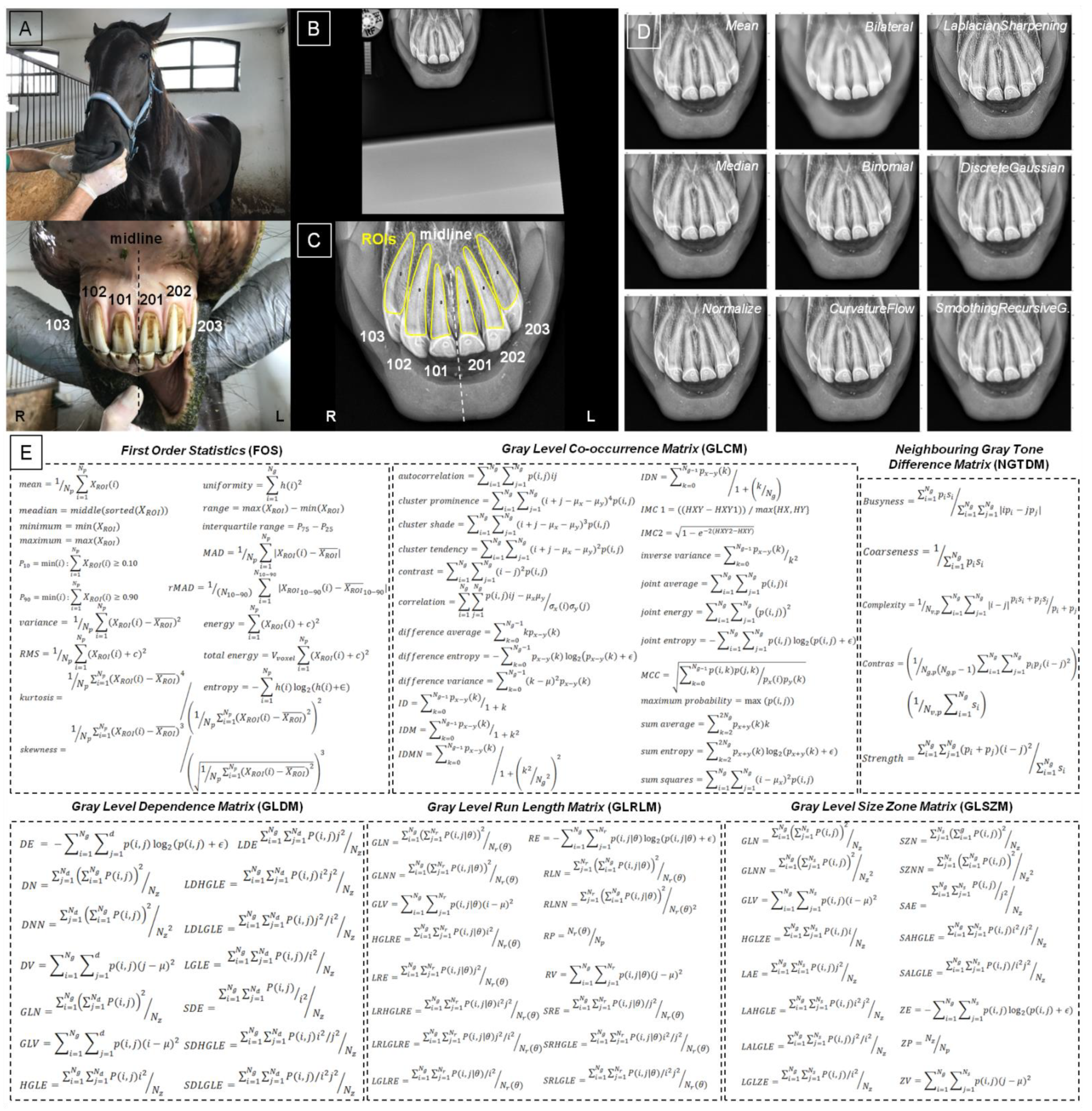
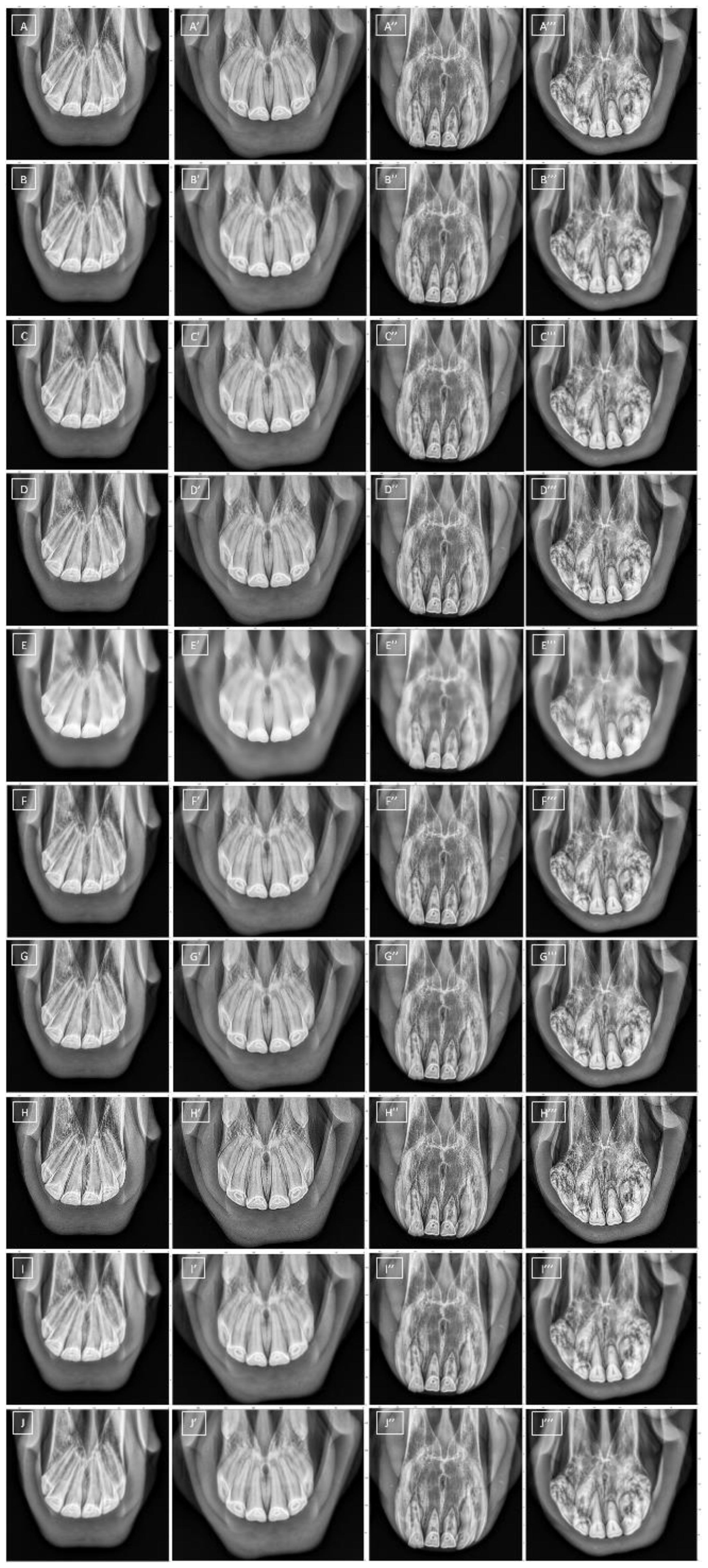
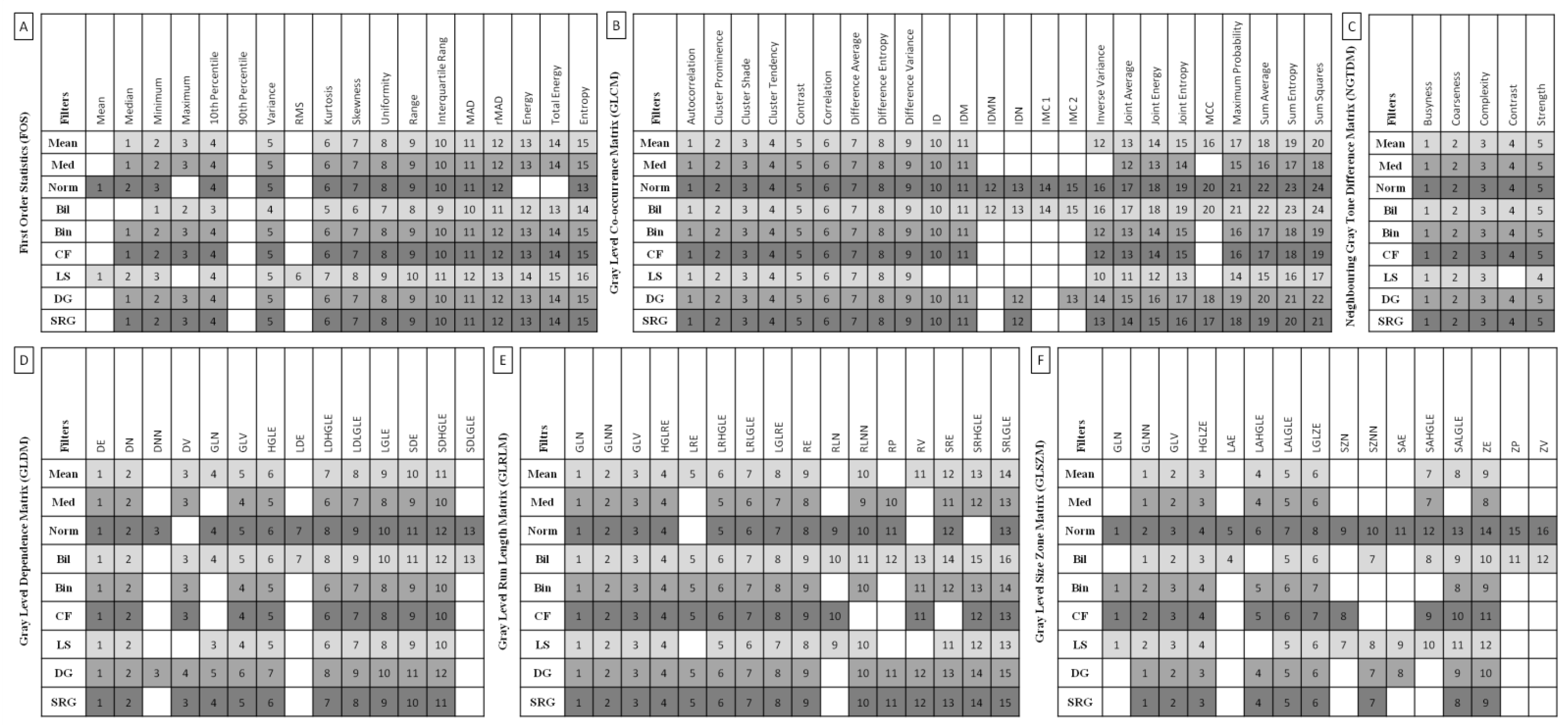
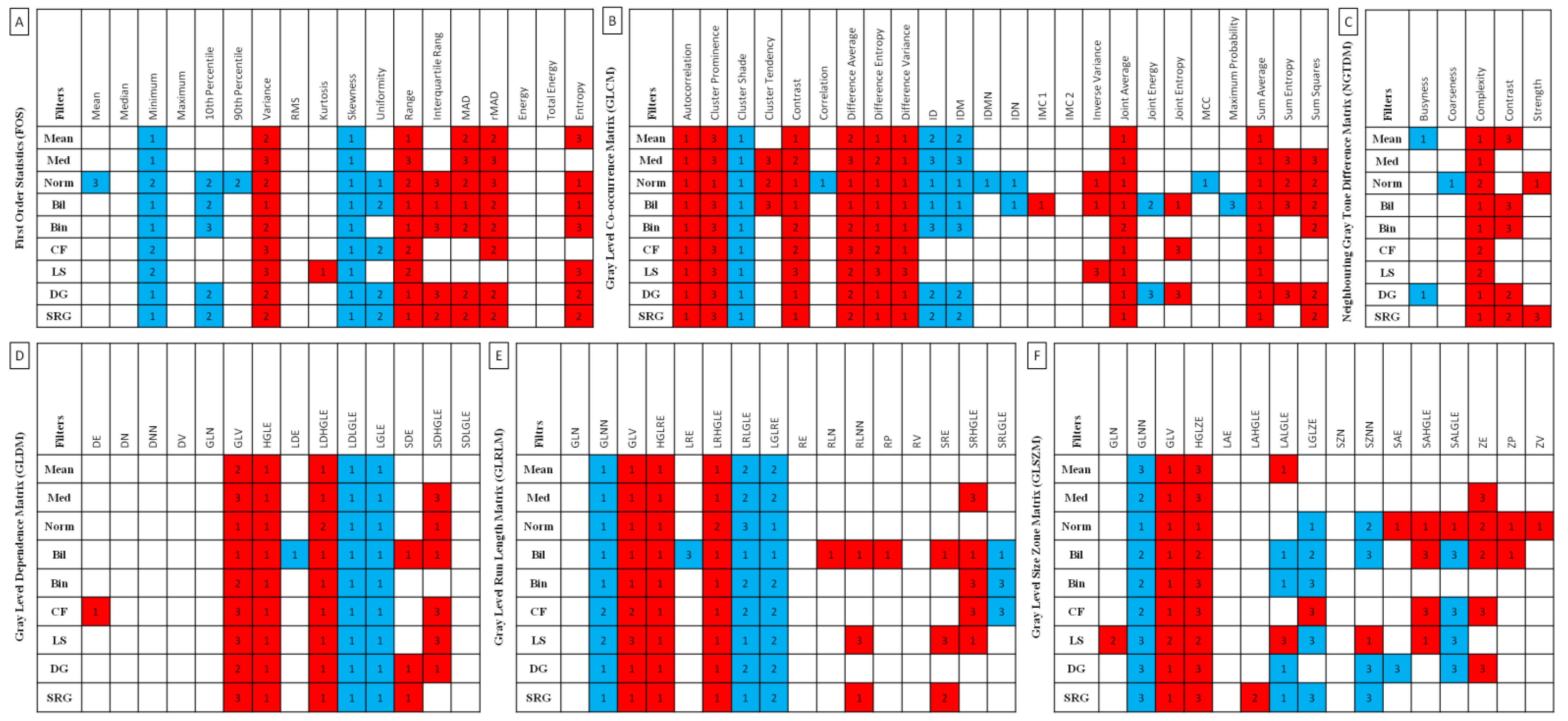
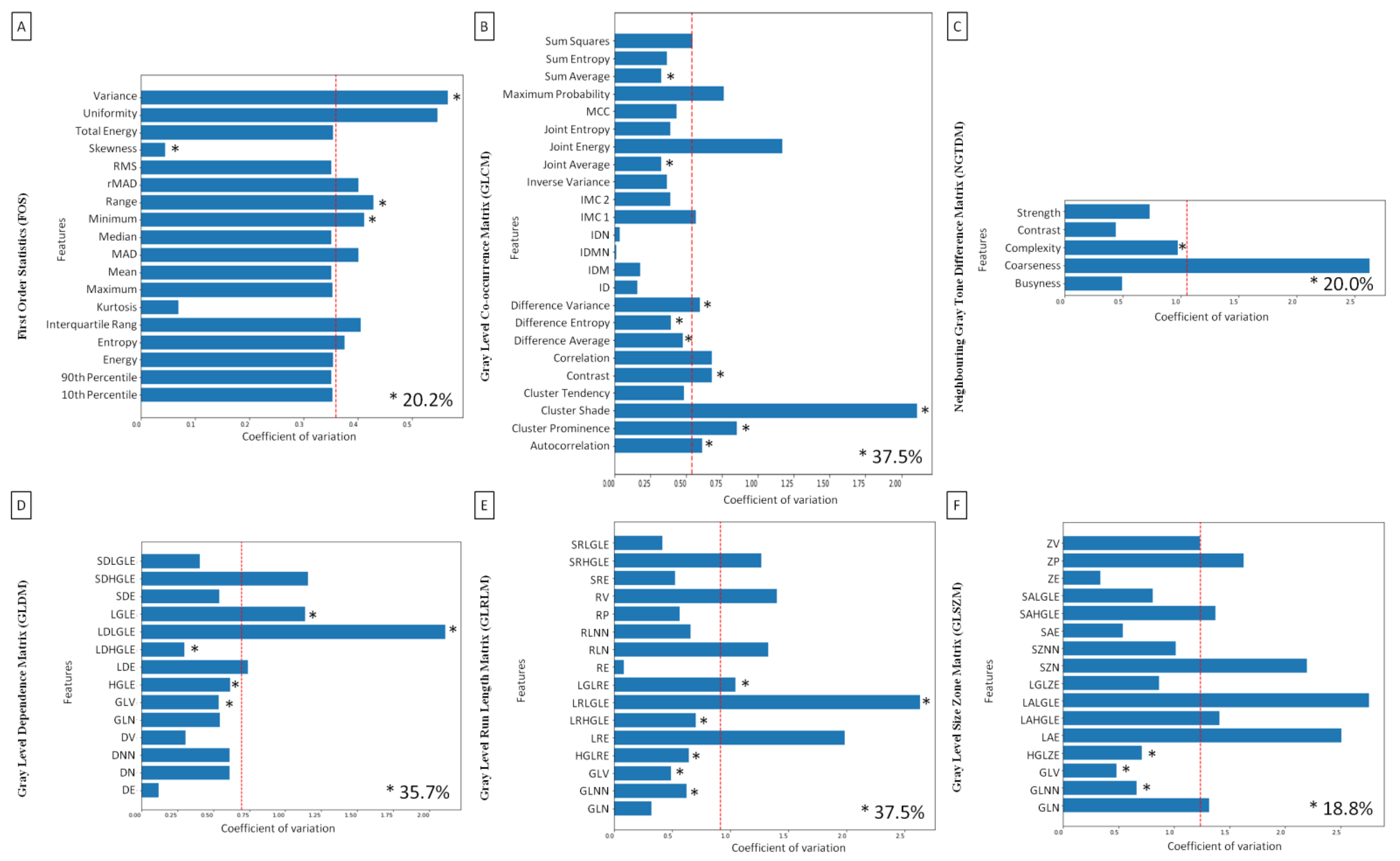
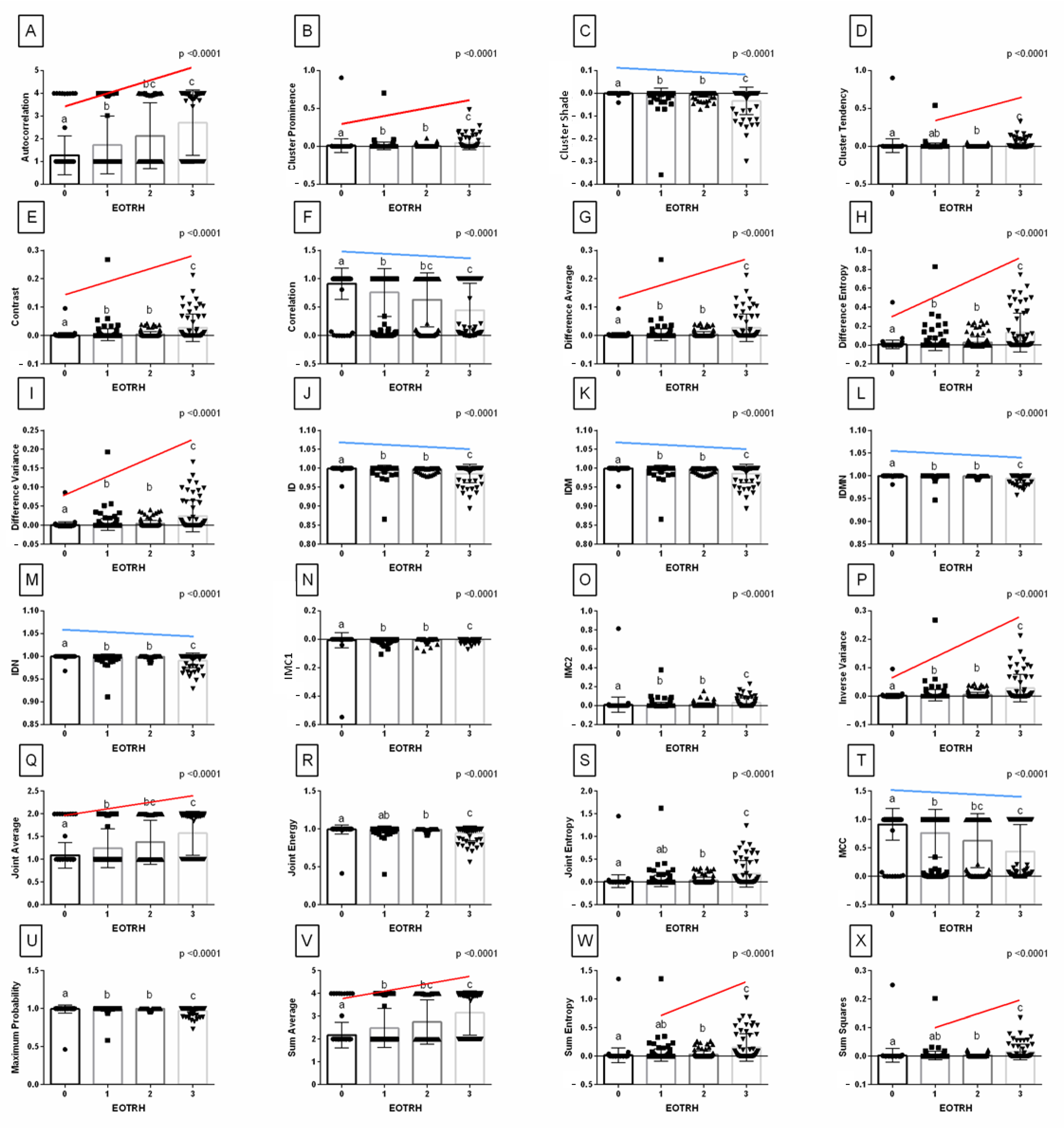
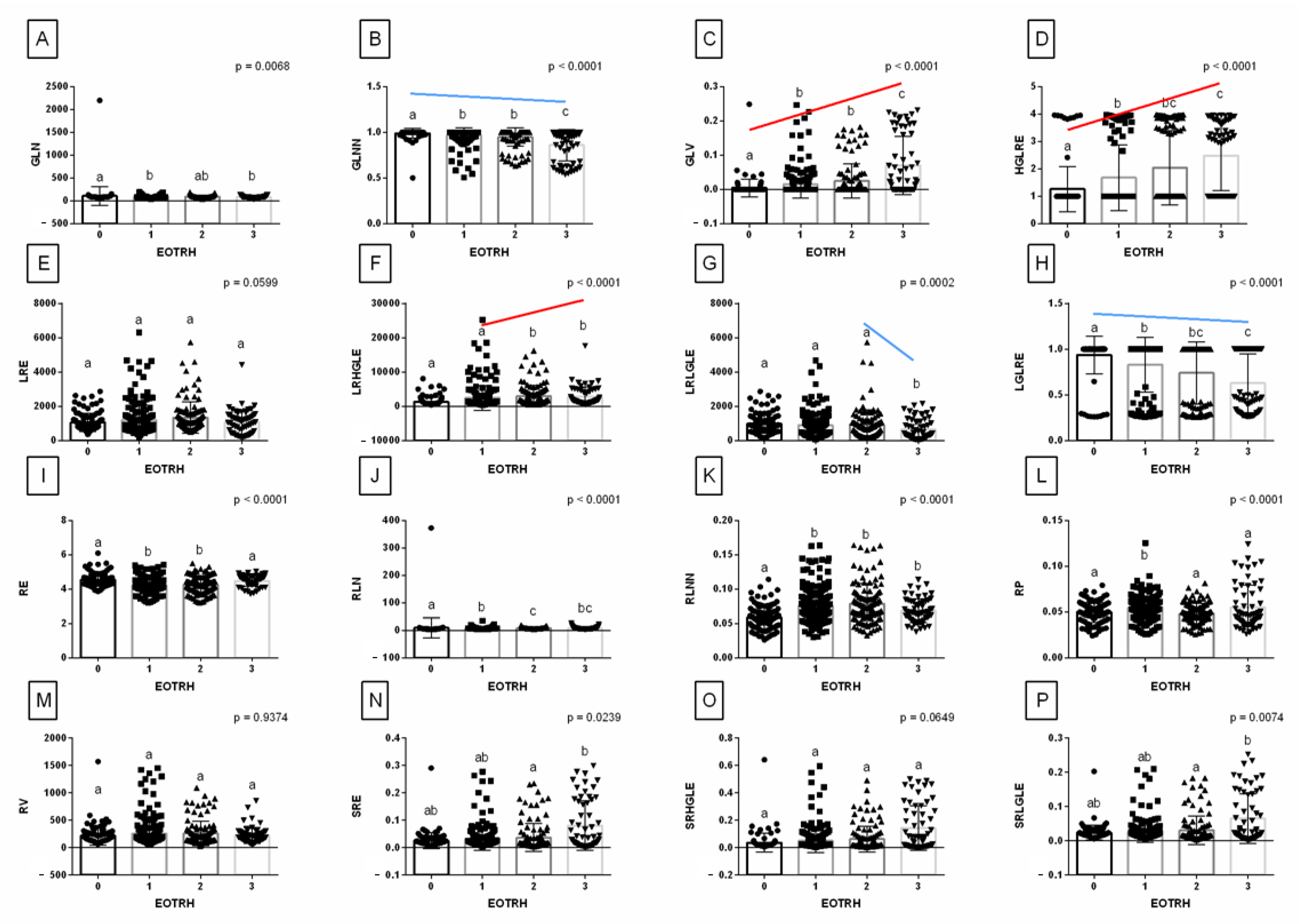
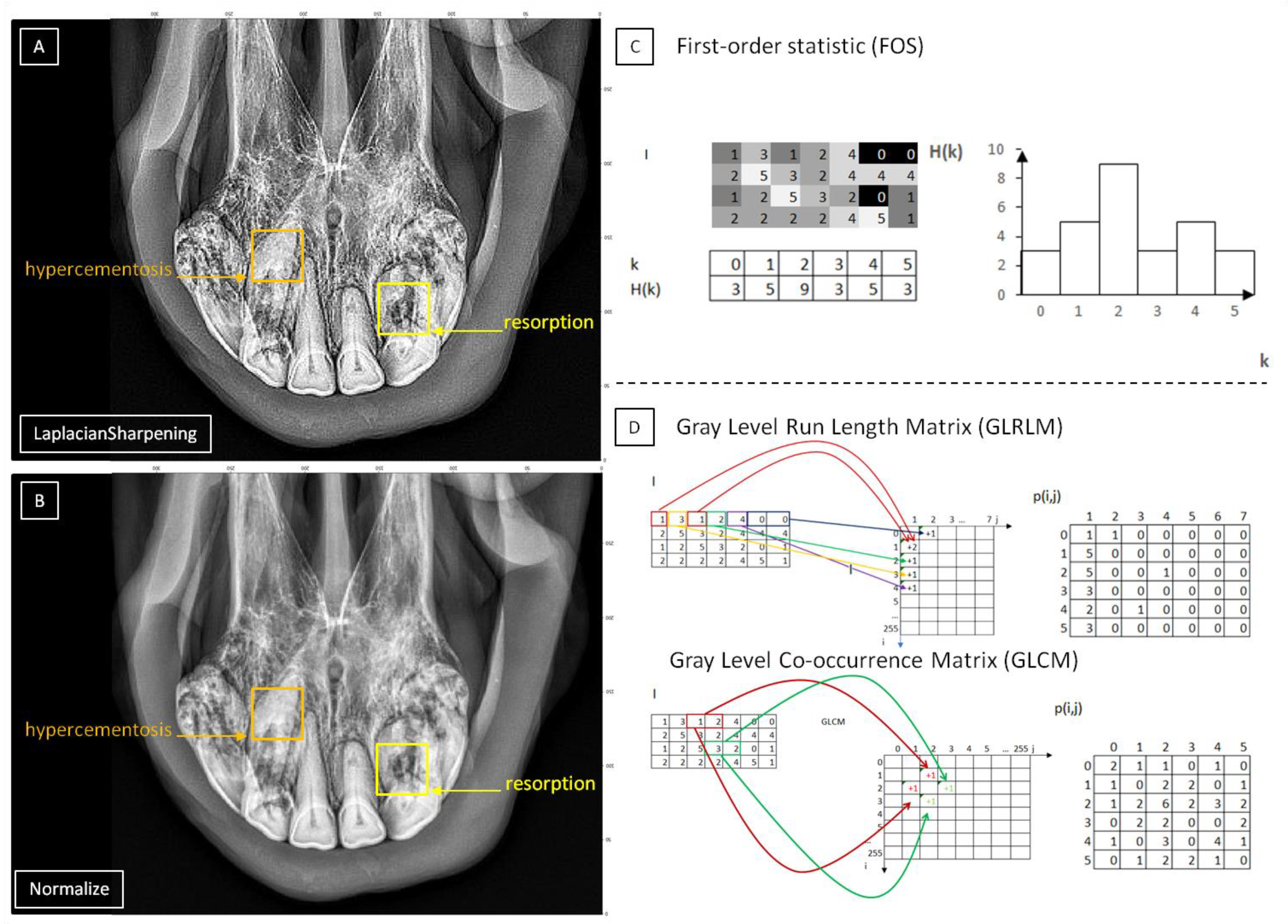
Publisher’s Note: MDPI stays neutral with regard to jurisdictional claims in published maps and institutional affiliations. |
© 2022 by the authors. Licensee MDPI, Basel, Switzerland. This article is an open access article distributed under the terms and conditions of the Creative Commons Attribution (CC BY) license (https://creativecommons.org/licenses/by/4.0/).
Share and Cite
Górski, K.; Borowska, M.; Stefanik, E.; Polkowska, I.; Turek, B.; Bereznowski, A.; Domino, M. Selection of Filtering and Image Texture Analysis in the Radiographic Images Processing of Horses’ Incisor Teeth Affected by the EOTRH Syndrome. Sensors 2022, 22, 2920. https://doi.org/10.3390/s22082920
Górski K, Borowska M, Stefanik E, Polkowska I, Turek B, Bereznowski A, Domino M. Selection of Filtering and Image Texture Analysis in the Radiographic Images Processing of Horses’ Incisor Teeth Affected by the EOTRH Syndrome. Sensors. 2022; 22(8):2920. https://doi.org/10.3390/s22082920
Chicago/Turabian StyleGórski, Kamil, Marta Borowska, Elżbieta Stefanik, Izabela Polkowska, Bernard Turek, Andrzej Bereznowski, and Małgorzata Domino. 2022. "Selection of Filtering and Image Texture Analysis in the Radiographic Images Processing of Horses’ Incisor Teeth Affected by the EOTRH Syndrome" Sensors 22, no. 8: 2920. https://doi.org/10.3390/s22082920
APA StyleGórski, K., Borowska, M., Stefanik, E., Polkowska, I., Turek, B., Bereznowski, A., & Domino, M. (2022). Selection of Filtering and Image Texture Analysis in the Radiographic Images Processing of Horses’ Incisor Teeth Affected by the EOTRH Syndrome. Sensors, 22(8), 2920. https://doi.org/10.3390/s22082920





